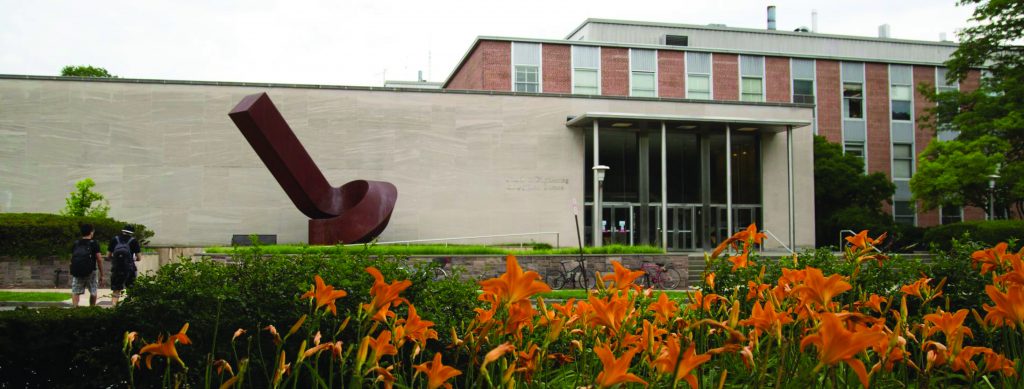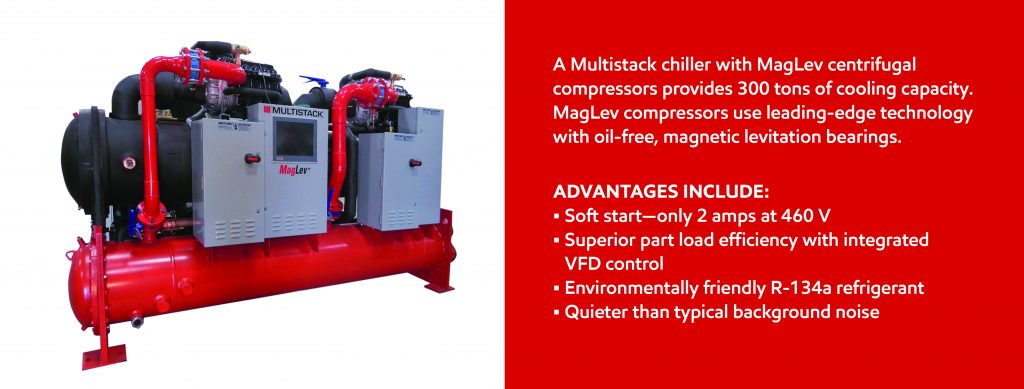Princeton University Engineers a more Efficient District Chiller Plant with Multistack
Princeton, New Jersey
Multistack MagLev Chiller — A Leader in Efficiency, Reliability, and Redundancy

Since the 1960s Princeton University’s district chilled water system has grown from serving a few thousand tons of cooling demand to a peak demand of 15,000 tons. The system now includes 180 buildings and 13 miles of chilled water piping connected to eight electric and steam driven chillers totaling 20,000 tons cooling capacity plus a thermal energy storage system of 40,000 ton-hours. The steam-drive chillers use “waste” steam from a 15-megawatt cogeneration system. Cooling loads include comfort cooling as well as mission-critical needs such as data centers and research facility equipment including lasers, electron microscopes and CT scanners. One of the district cooling system “customers” is the Princeton Engineering Quadrangle, aka E-Quad, that includes research buildings needing uninterrupted cooling. It would be highly expensive to lose or shut down cooling to E-Quad facilities, potentially ruining ongoing research projects.
Challenge
The Princeton chilled water system previously experienced low Delta-T issues. During the past two summers on warm days the average Delta-T was only seven degrees. Numerous upgrades and maintenance solutions including pipe and coil cleaning, coil replacement, and control upgrades proved helpful, but the Delta-T remained excessively low.
Complicating the situation was the E-Quad’s expanding research activities and growing 24/7 demand for chilled water, which was becoming increasingly difficult to satisfy. During winter months, the E-Quad represents a large part of the entire campus cooling demand. Additionally, the E-Quad is the farthest from the central chiller plant of all buildings on campus.
In short, E-Quad chilled water demands required the district central chilled water system to not only run colder than needed, but also pump over 1,000 GPM chilled water more than necessary across the longest distance—all year long, non-stop. With so many chillers and pumps operating to meet the E-Quad requirements, the impact on efficiency and energy costs was huge. And, the E-Quad’s need for low temperature chilled water greatly reduced free cooling opportunities.
New Thinking for a New Solution
The Princeton University Facilities Engineering Department teamed up with Travis Smith at Smith Engineering in New York City, to create a new solution. Working with Princeton Energy Plant Manager Ted Borer (PE, CEM, LEED AP), the team installed a 300-ton “booster” chiller supplied by Multistack and SRS Enterprises, the Multistack representative for New York and New Jersey. Borer explained, “This chiller takes chilled water from the central system and further cools it to meet the E-Quad’s low temperature chilled water needs. Then, rather than rejecting the chiller and E-Quad building heat through a cooling tower, the primary leaving chilled water is pumped through the condenser side of the booster chiller before returning to the central chiller plant.”
This strategy not only provides the E-Quad with chilled water at its required temperature, it increases the heat in the central chiller plant return water and the apparent Delta-T of the district system.
Another challenge overcome was the limited basement equipment room space. The Multistack chiller is very compact and was rigged into place through a grate adjacent to the building. No teaching, research or laboratory activities were disrupted during installation.
Results
In addition to meeting the E-Quad chilled water needs and improving system operation, this innovative 300-ton solution rectified the inefficient operation of Princeton University’s entire 20,000- ton central chiller plant. The Multistack chiller serves as a booster to provide the E-Quad with its needed colder than usual chilled water thereby allowing the central plant to provide bulk chilled water as high as 48 F whenever it is not necessary to remove latent heat—i.e. most of the winter. Raising the district chilled water system temperature dramatically extends the free cooling season for even greater energy savings.
Travis Smith said, “Simply put, the E-Quad buildings are no longer ‘driving the bus’ for the entire campus chilled water plant.”
Installation of the Multistack chiller also allowed Princeton Facilities Engineering to cost-justify installation of a central, free cooling heat exchanger allowing maximum cool weather free cooling for additional energy savings. Overall annual energy savings are huge.
Efficient, Smooth Running
Year-round chilled water system flow rate is now dramatically reduced—from 1,800 GPM to only 800 GPM—resulting in significant energy savings. The higher Delta-T greatly reduces the number of central chillers and pumps needed to run.
The Multistack chiller adds reliability and buffers the E-Quad against chilled water temperature variations. If the booster chiller fails, the central chiller plant can revert to producing lower chilled water temperature as needed. Much of the efficiency improvement is due to the Multistack chiller’s MagLev compressors that use oil free, magnetic levitation bearings.
Referring to the MagLev™ compressors, Travis Smith pointed out an added benefit: “Magnetic levitation bearings also drastically reduce equipment vibration compared to traditional bearings—a significant requirement for the sensitive laboratory and research equipment within the building.”
Overall, the Multistack MagLev chiller offers sustainable, documentable high performance with reliability, redundancy, low maintenance and lowest total cost of ownership— all in a compact chiller built in the U.S.A!
- Unrivaled efficiency—complies with ASHRAE 90.1 standards. Qualifies for USGBC LEED credits. All MagLev chillers are run-tested on Multistack’s AHRI certified test loop.
- Among the HVAC industry’s lowest per-ton refrigerant charge.
- Unequaled flexibility and control— control multiple compressors of different capacities with optimum performance and efficiency at full load and part load.
- Industry’s best unloading capability without condenser water temperature relief.
- Multistack MagLev chillers with FlexSys controls provide fast response—can unload from full load to minimum flow in one minute, run at reduced flow for a minute, then reload to full load a minute later!
- Smallest footprint per ton of capacity. Ideal for retrofit or new construction projects—units up to 330 tons capacity fit through a 36-inch door.
- Sustainability—oil-free compressor technology means no refrigerant-entrained oil to hinder heat transfer and reduce efficiency. No lubrication system means fewer parts, greater reliability, and lower maintenance costs.
- Redundancy achieved thru multiple compressor design featuring lowest failure rate in the industry
Ted Borer said, “I am not aware of any other installation where primary chilled water is circuited through the evaporator and then the condenser sides of a chiller—effectively operating that chiller as a heat concentrator within a district cooling application…it represents a very subtle and elegant solution to a problem that caused inefficient operation of the entire district energy system.”
Borer added, “Plant operators report running fewer chillers at any given load. They are now limited by chiller capacity, not tube velocities. It’s 90 F outside right now and we have one chiller delivering 3,800 tons and the TES system providing 4,700 tons—with no other chillers running! The past two summers our average chilled water return temperature was 48 F.
In August 2016, Borer reported, “The new E-Quad booster chiller continues to provide huge benefits to our chilled water system. It produced 153,000 ton-hours last month at an efficiency of 0.55 kW per ton. More importantly, E-Quad’s HVAC systems only created an 8.0-degree temperature rise in the chilled water, but thanks to the new chiller the campus cooling system experienced over 26-degree Delta-T from the building and correspondingly reduced flow rates.
“The E-Quad used to be the limiting customer based on chilled water supply temp and we’d get complaints above 41 F. Now we average 42.6 F with no complaints. Before we had to pump about 2.5 GPM per ton of cooling—now we’re at only 2 GPM and dropping as the weather warms and return temperatures rise. The TES tank ‘warm’ temperature is now 54 F instead of 52 F. This provides 10 percent more TES storage capacity.”

Princeton University Receives 2017 IDEA Innovation Award
“IDEA (International District Energy Association) values the open exchange of best practices, sharing of new technologies, and lessons learned from industry peers that drive progress and advancement in district energy. Since 2013, IDEA has been recognizing the best new ideas in the industry through its annual Innovation Award. Presented by Bob Smith of RMF Engineering, the 2017 Innovation Award was given to Princeton University and Smith Engineering for creatively addressing an industry-wide problem of low Delta T in a remote location of its chilled water distribution system. Tom Nyquist accepted the award on behalf of Princeton University for their innovative Heat Concentrating Chiller solution to a long time.
About Princeton University
Chartered in 1746 and the fourth-oldest college in the United States, Princeton is an independent, coeducational, non-denominational institution providing undergraduate and graduate instruction in the arts and humanities, social sciences, natural sciences, and engineering. Princeton is a world-renowned research universitywith more than 1,100 faculty members and approximately 5,200 under-graduate and 2,600 graduate students. Princeton University graduates, faculty, staff and associates are a who’s who of Nobel and Pulitzer prize winners plus presidents, CEOs, astronauts, military and government leaders, actors, athletes and leaders in virtually every field of human endeavor.
The Princeton School of Engineering and Applied Science comprises five buildings of the Engineering Quadrangle with interconnected wings housing 25 classrooms, 120 laboratories, a machine shop, more than 125 faculty offices and study spaces, and a cafe. According to Princeton, “Over the last 13 years, the engineering school has seen significant growth— undergraduate enrollment is up 80 percent, graduate enrollment has expanded by 18 percent, and the faculty has grown by 12 percent. 25 Percent of Princeton undergraduates are majoring in engineering.”



